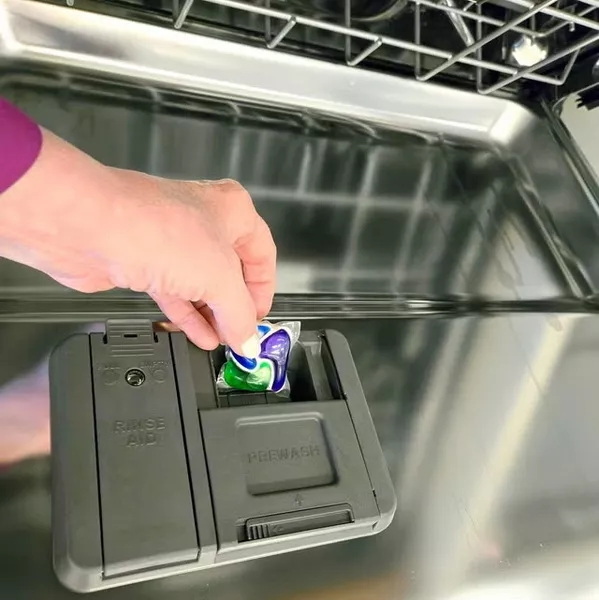Dongguan UFine Daily Chemical Co.,Ltd.
- All
- Product Name
- Product Keyword
- Product Model
- Product Summary
- Product Description
- Multi Field Search
Views: 222 Author: Tomorrow Publish Time: 11-28-2025 Origin: Site











Content Menu
● Understanding Dishwasher Pods
● Characteristics of Older Dishwashers
● Compatibility of Pods with Older Dishwashers
● Common Problems and Solutions
● Detergent Impact on Machine Longevity
● Pod Benefits for Older Dishwashers
● Alternative Detergent Types for Older Models
● Tips for Best Pod Performance in Older Dishwashers
● Environmental and Safety Considerations
● FAQ
>> 1. Will pods dissolve in cold water?
>> 2. Can I place the pod directly in the dishwasher tub?
>> 3. Should I use multiple pods for large loads?
>> 4. Are pods safe for older dishwasher components?
>> 5. Which detergent type works best for aging dishwashers?
Modern dishwasher pods have transformed kitchen cleaning, offering a convenient, pre-measured combination of detergent, rinse aid, and other cleaning agents wrapped in a water-soluble film. This innovation ensures consistent dosing, reduces mess, and simplifies dishwashing. But many people with older dishwashers still ask: can these pods be used effectively in vintage machines? This article examines the compatibility of pods with older dishwashers, offers tips to optimize results, discusses alternatives, and answers common questions.

Dishwasher pods, also known as tablets or packs, contain a precise quantity of cleaning agents wrapped in a film that dissolves during the wash cycle. They often include enzymes for grease breakdown, oxygen bleach for stain removal, and rinse aids to reduce spots. Compared to powders and liquids, pods deliver consistent cleaning power without measuring or spilling. However, they rely on proper water temperature, spray arm function, and detergent dispenser design to perform optimally—factors that can present challenges in older appliances.
Older dishwashers are typically models produced 10-20 or more years ago. They often lack advanced sensors, efficient heating elements, and specially designed detergent compartments found in modern dishwashers. Older units may have:
- Lower hot water temperatures, often under 120°F (49°C)
- Less powerful or partially clogged spray arms
- Smaller or irregular detergent dispensers
- Simpler wash cycles, sometimes shorter or less thorough
These limitations affect how pods dissolve and distribute detergent, potentially leading to residue or undercleaning.
Generally, older dishwashers can use pods, but with some caveats.
Water temperature is critical. Most pods require water at or above 120°F to dissolve correctly. If the dishwasher fills with cooler water, the pod's film may not dissolve completely, leaving residue. Running the kitchen hot water before starting the cycle helps mitigate this.
Spray arm functionality also matters. Older arms may accumulate mineral deposits or debris, restricting water flow and detergent spread. Cleaning spray arms regularly improves pod effectiveness.
Detergent dispenser size and design can vary. Some older models have compartments too small or awkwardly shaped to accommodate pods. In these cases, placing the pod directly on the bottom rack during the cycle ensures proper dissolving.
Users switching to pods in older dishwashers commonly report:
- Undissolved pod film or detergent residue
- Spots or film on dishes
- Pods stuck inside detergent doors
To solve these problems:
- Verify the dishwasher's water temperature. Run hot water at the sink before starting.
- Clean spray arms and filters to maintain strong water jets.
- Avoid short or eco cycles. Use full or heavy-duty washes for better dissolving time.
- Place pods directly on the bottom rack if the dispenser is unsuitable.
- Store pods in airtight containers away from humidity to keep effectiveness.
These steps enable most older dishwashers to clean as well as newer models with pods.

Pods themselves do not harm dishwasher interiors. Their balanced formulas and mild abrasives suit household machines. Problems arise only if residue accumulates from incomplete dissolution, which can clog filters or spray arms over time. Regular maintenance and running cleaning cycles prevent buildup and extend older dishwasher life.
Even with vintage machines, pods provide:
- Simple dosing without measuring or spills
- Built-in rinse aids reducing spots and film
- Consistent cleaning without overuse of detergent
- Time savings with no messy powders or liquids
Thus, pods modernize the washing experience in old appliances.
Some owners prefer powdered detergents for older machines because powders dissolve easily and allow dosage control. Powders are also better in hard water areas where limescale can build up. Liquid detergents often perform worse since they wash away early during cycles and may lack enzymes or bleach in effective amounts.
Testing powdered detergents or combining powder in the pre-wash compartment with pods in the main wash can optimize cleaning for older units.
- Pre-run hot water and fill the machine with warm water.
- Keep spray arms free of debris and calcium buildup.
- Use heavier wash cycles lasting longer for full pod dissolution.
- Avoid overloading racks to ensure water circulation.
- Store pods dry and sealed to prevent clumping or sticking.
Many pods feature biodegradable films and eco-friendly formulas. Using one pod per full load minimizes waste. Store pods securely away from children and pets since the concentrated detergent is harmful if ingested.
Older dishwashers can effectively use pods with correct adjustments. Ensuring warm water, clean spray arms, and proper pod placement enables thorough cleaning without residue or damage. Pods bring convenient, consistent detergent dosing to classic machines, prolonging their usability and simplifying kitchen cleanup.

No. Pods require hot water, generally above 120°F, to dissolve fully. Cold water can leave residue and film on dishes.
Yes. If the dispenser is too small or slow to open, placing the pod on the bottom rack helps it dissolve better.
No. One pod is formulated for a full load. Using extra pods can cause residue and doesn't improve cleaning.
Yes. Pods are designed to be mild and safe for all dishwasher types if fully dissolved.
Pods and powders tend to outperform liquids. Powders allow dosage control, which may benefit very old or less efficient machines.
[1](https://www.choice.com.au/home-and-living/kitchen/dishwasher-detergent/articles/dishwasher-tablets-and-pods-vs-powders-which-is-best)
[2](https://www.whirlpool.com/blog/kitchen/best-dishwasher-detergent.html)
[3](https://www.reddit.com/r/Frugal/comments/6mu4cv/detergent_for_old_dishwasher/)
[4](https://www.consumerreports.org/appliances/dishwasher-detergents/best-dishwasher-detergents-from-consumer-reports-tests-a9174621249/)
[5](https://www.finisharabia.com/ultimate-dishwashing-guide/maintenance-and-care/the-ultimate-guide-to-choosing-the-best-dishwasher-detergent/)
[6](https://www.nytimes.com/wirecutter/reviews/best-dishwasher-detergent/)
[7](https://www.reddit.com/r/HomeMaintenance/comments/1achy17/best_form_of_dishwasher_detergent/)
[8](https://www.consumerreports.org/appliances/dishwasher-detergents/buying-guide/)
[9](https://www.youtube.com/watch?v=z67iwoEkXkU)
[10](https://automaticwasher.org/threads/liquid-detergents-or-pods-in-old-dishwashers.87128/)